Tip - Learn About Malicious Links

Know how to determine if a link is malicious or safe, and hover over links before clicking to evaluate their legitimacy.
Email attacks are always evolving, and due to the pandemic, the digital threat landscape is far more dangerous than ever. Security researchers estimate that there has been a 600% increase in phishing campaigns due to COVID-19, and the majority of these attacks rely on malicious links to steal credentials or deliver malware.
Despite the fact that HTML email allows users to hover over a link to view its destination, the reality is that the majority of us do not engage in this security best practice. Malicious URL protection eliminates the risk of a potentially devastating “wrong click” that could result in the submission of credentials or the loss of control of one’s device through the download of ransomware, spyware or other malicious executable software.
- Guardian Digital EnGarde Cloud Email Security identified and blocked more phishing emails containing malicious links in May of 2020 than in any month prior since the company’s inception over two decades ago.
- A recent survey conducted by Osterman Research found that, on average, 24% of a security analysts’ 40-hour workweek is spent investigating, detecting or remediating phishing emails.
Implementing URL effective URL Defense helps create a safeguarded environment around the user - mitigating the risk of an employee submitting a password or downloading malicious spyware, ransomware or other malicious executable software on your systems.
Safeguard Your Inbox from Malicious Mail
Email Security
Effective email security is contingent upon defense in depth. No single security feature is sufficient in fortifying email against sophisticated modern exploits. Businesses are becoming increasingly aware of the threats they face online - the majority of which involve email. Email security defenses are evolving, desperately trying to keep pace with sophisticated emerging attacks stealthily crafted to evade detection. However, there is one key area where even the most innovative, modern email security solutions consistently fall short: managed services. An effective email security solution cannot simply be selected and purchased, leaving the responsibility of configuration and management in the hands of the administrator.
Managed Services
Managed Services are a key component of an effective email security solution that is too often overlooked. Ongoing expert system monitoring, maintenance and support can simplify administration, improve security and reduce costs - delivering a rapid return on investment (ROI).
Email authentication protocols - namely, SPF, DMARC and DKIM - are crucial in preventing sender fraud and protecting sensitive information. These key standards verify sender identity and confirm the legitimacy of email communications.
Traditional spam filters and signature-based antivirus software alone are no longer sufficient to protect users, systems and critical data. Spammers are now using advanced, stealthy techniques such as social engineering to evade spam filters and deceive users, and complex polymorphic viruses are capable of modifying themselves to avoid detection. Modern spam and virus protection requires adaptive, layered defenses, such as those seen in EnGarde.
Guardian Digital recognizes that setup and management are significant hurdles for SMBs looking to implement an effective cloud email security solution, and that protecting against today’s advanced threats requires a level of expertise beyond what the majority of businesses can find within their organization.
Other key benefits of securing your business email with Guardian Digital EnGarde Cloud Email Security include:
- Keeps you ahead of phishing, ransomware and other persistent and emerging threats with real-time malicious URL protection
- Protects sensitive information and prevents email fraud with layered sender authentication protocols
- Fortifies cloud email against credential phishing and account takeovers
Next Steps
Malicious URL protection technology is most effective when implemented as part of a comprehensive, defense-in-depth approach to email security. We strongly recommend that users select a multi-layered cloud email security solution that seamlessly integrates with the cloud platform they are using, providing critical additional layers of defenses. Look for a solution that incorporates advanced, real-time malicious URL protection techniques - mitigating the risk of human error and safeguarding cloud email accounts in this time of heightened vulnerability.
Want to learn more about malicious URL protection? Get in Touch >>
CyberSecurity Month
- Tip - Avoid Phishing Emails
- Tip - Being Cautious of Spam Email
- Tip - Be Wary of Malicious URLs
- Tip - Protect Against Spoofing & Sender Fraud
- Tip - Protect the Privacy of Your Email with TLS
- Tip - Don't Rely on Native Microsoft 365 Email Protection Alone
- Tip - Implement TLS to Keep Your Email Secure
- Tip - Endpoint Security Is Not Enough
- Tip - Conduct Regular Email Security Audits
- Tip - Configure Email Account Settings with Security in Mind
- Tip - Learn How To Spot Threats to Business Email
- Tip - Backing up Your Data and Isolate Your Backups Offline
- Tip - Protect Business Email from Phishing Attacks
- Avoid Sending Sensitive Information Over Email
- Tip - Learn About Malicious Links
- Tip - Prevent Zero-Day Attacks
- Tip - Business Email Is for Business Only
- Tip - Learn How To Identify Social Engineering Attacks
- Tip - Know Your Email Risk
- Tip - Safeguard Your Inbox from Malicious Mail
- Tip - Understand How Phishing Attacks Are Carried Out
- Tip - Know the Steps in a Spear Phishing Attack
- Tip - Familiarize Yourself with the Anatomy of a Whaling Attack
- Tip - Understand How Malware Attacks Work
- Tip - Learn the Steps in a Ransomware Attack
- Tip - Understand the Phases of a Business Email Compromise (BEC) Attack
- Tip - Know What Zero-Day Attack Is & How It Works
- Tip - Familiarize Yourself with the Phases of an Account Takeover (ATO) & Lateral Phishing Attack
- Tip - Learn the Steps in a Social Engineering Attack
- Tip - Understand the Types of Email Viruses to Be on the Lookout For